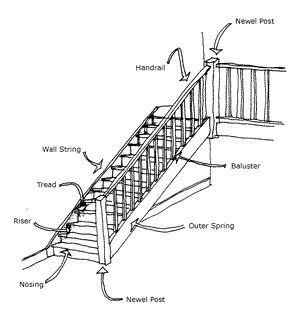Stair Design and Construction
What we need to know about stairs.
Interior designers can really make a statement with stairs. The design and finish of the staircase (unlike a color or wallpaper or even a lighting system) will usually be a permanent feature of a home or building. Although they are functional they have an aesthetic prominence as well and therefore it is important to understand how they are constructed, what the components are and the various systems or designs that can be used to establish the design parameters.
What are Stairs?
Stairs are a system of steps that allows the passage of people and objects from one level to another. They can be made from timber, concrete and sometimes steel or stone aluminium and with modern technology and materials even glass.
Stair Definitions
Flight
The steps between levels including landings.
Landing
An area at the top or part way up the stair that either acts as a resting place, a change of direction or is the end of the stair.
Tread
The surface of a step, which you tread or step on.
Riser
The distance between each step. I.e. the vertical space between each step.
Nosing
The front edge of the step or tread that hangs over the riser.
Going
The measured horizontal distance between nosings.
Rise
The actual or measured distance between treads.
Total Rise
The total vertical distance from floor to floor.
Total Going
The total horizontal distance of the stair.
PitchLine
An imagined line that stretches from nosing to nosing for the length of the stair.
Pitch
The angle that the flight of stairs is built at.
Headroom
This is the distance from the pitch line to the next surface above it. E.g. the ceiling or soffit above. The normal minimum is two metres.
String
The angled beam or member at each side of the stair that supports the treads.
Wall String
As above but fixed to the wall.
Outer String
As above but independent of the wall.
Designer Note. Stairs tend to take up a great deal of room. They are functional as well as aesthetic. Consequently the type of stair employed will be determined by these three factors.
The Function, The Look, The Available Space
There are many forms of different stair layouts from a straight flight, to a series of intricate curves and landings, however the basic principle of stair design does not alter. Stairs should be
comfortable to walk up not only for the young but also for the old.
The steeper the staircase the more difficult it will be to climb. A steep stair can be compensated with additional landings. However
it will be a balance between the amount of room you have for the stairs and the distance between floors.
The going will always be shorter than the tread but the tread should be, if at all possible large enough to accommodate the whole of the human foot.
Think of access between levels as a generous stair or a mean stair.

Types of Stair Design, Stair Function and Construction
The basic forms of stairs are as follows:
Straight Flight
A set of stairs sometimes with a central landing, in one direction only linking the floors.
Dogleg
The flight turns on itself at a landing to go back in the reverse direction. There is no opening between the stairs therefore the landing will be double the width of the stair.
Open Well Stair
This is leaving a space between the stairs. It may occur on two three or four flights or more. In effect the stair well is left open. Walls to the outside and balustrades to the inside. There is a view from floor to floor through the well.
Design Note: Where the string of a stair meets the skirting board careful attention must be given to this detail as of the two components one is structural and the other decorative. Try and get the string to match the skirting or make it a design piece (in keeping with the house decoration) on its own.
The Spiral Stair
The stair rises and is supported around a central column. All the treads are tapered. These (depending on your building code) may only be used for certain situations. It also depends on the width of each tread as each tread has a minimum size that it can be to support a foot safely. Each step must be tapered. The outside width must be a wider than the inside width.
The Curved Stair
This is a similar to the spiral stair in that some if not all of the treads are tapered. However the basic support system for a curved stair is as for a straight flight with outer and inner strings.
What does the stair have to do?
Obviously it has to get you from one level to the next but it also has some other functions that are not quite so obvious. It must be able to carry as much load if not more than the floor it is accessing. E.g. the piano to be moved upstairs goes via the stair so it also copes with a live/moving load, therefore the force exerted is not just down. It must be large enough to take the size of all objects and persons on the stair.
People must be able to pass safely on the stair. It must be stable when force is applied to the stair i.e. it can not be allowed to have a large degree of flexibility or movement. In many cases this stair well need to be built from materials that do not easily catch fire as another function of the stair is that it is a means of escape in the case of fire.
Critical Sizes For Stairs
These will vary from country to country but generally as a rule of thumb (confirm with the building code or regulations and all local building authorities) the stair needs to be as wide as a doorway, 760 minimum but preferably 900 millimeters. Each riser should be no more than 160 – 165 millimeters in height to make a reasonably comfortable stair however the riser will be determined by the amount of going and space you have and also by the amount and type of use of the stair. A maximum riser would be 200mm (8 inches). Each rise should be no more than 2.4 meters.
Visit the website dedicated to stairs for more information on stair design and photographs of staircases.
